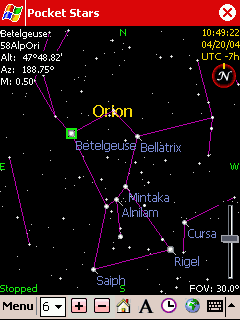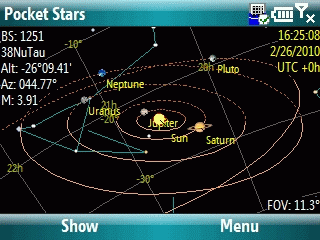Pocket Stars PDA
is a high accuracy star chart, astronomy reference, celestial navigation tool, and
guide to the heavens for Windows Mobile Pocket PCs. Pocket Stars PDA combines rich
capabilities with simple and quick navigation.


Star Chart Features
- Supports all Windows Phones and Professional and Classic PocketPC devices running WM6/6.5 and WM5, and all
resolutions including QVGA, VGA, square, portrait and landscape modes.
- User interface optimized for simple and fast star, planet, Messier, and Caldwell
object identification. Single click on any body to get the name, designation,
calculated altitude, azimuth, and magnitude. Drag the cursor to scroll the
chart. Zoom in and out with a single click.
- 3D Orrery display of solar system and background stars and constellations.
- Display of orbital paths for inner solar system bodies showing daily positions for
one year centered on current date.
- Animation of the sky in increments of hours, days, weeks, or months.
- Manual or automatic control of star magnitudes. Simple control over which objects
to display. Overall, these features give great control of visual clutter given the
limited screen real estate on the Pocket PC.
- Black, white, and red star chart colors for normal, bright, and night viewing conditions,
respectively. Complete skinning or customization of star chart colors.
- Chart can be rotated to any of the 16 compass points and also flipped along the
North - South axis. This allows the either overhead (East and West reversed) or
non-overhead (East and West normal) viewing.
- Polar grid with hour angle and declination labels.
- Zenith grid.
- Search and scroll to constellation, body, star, or Messier / Caldwell objects.
- User location set by clicking on map, city selection, GPS, or by entering Latitude
and Longitude.
- Chart can be "live, realtime", or static for any user selected time.
- Core positional calculation routines based on "Novas" (Naval Observatory
Vector Astrometry Subroutines Version 2.0.1).
- Star data is from the Bright Star Catalog (5th Revised Edition), comprising the
9110 brightest stars using J2000 equatorial positions and the International Celestial
Reference Frame (ICRF). Corrections are performed for proper motions andparallax.
- Planet ephemeris data from Jet Propulsion Laboratory using the DE405 database. DE405
is JPL's latest planetary ephemeris with correction for both nutations and librations.
DE405 uses the J2000 International Celestial Reference Frame (ICRF). The portion
of this database provided with Pocket Stars covers the years CE 2000 to CE 2020.
Other ephemeris date ranges are available for download here.
Celestial Navigation Features
- Reduction from sextant altitude to observed altitude for any of the
9110 stars, nine planets, and sun and moon. Watch this
movie to see how it's done.
- Corrections for observer height (DIP), refraction (temperature and atmospheric pressure),
and vessel movement.
- Position from intercept and azimuth by calculation for multiple sextant observations
following procedures in "The Nautical Almanac" by the United States Naval
Observatory.
- Any number of sextant observations can be individually enabled to compute a best
fit when computing a FIX. Results may be plotted, showing the assumed position (AP),
FIX, and observations with intercepts and amplitudes.
- Intermediate calculations for each observation can be displayed, with selectable
formats (DD.dddd, DD MM.mm, DD MM SS) for degrees, minutes, seconds.
Other Features
- Rise, set, and meridian times for all solar system bodies.
- Lunar Phase calendar and animation showing the relative positions of the earth,
moon, and sun.
- Images and physical data for planets, moon and sun. Optional display of all 110
Messier objects through separate free download.
- Calculators for Great Circle Distances, Range and Bearing, Horizon Distances, Julian
Day, and degree minute seconds conversions.
- Full screen mode.
Purchase
Trial Version
Compatible Devices
Certification
Money Back Guarantee